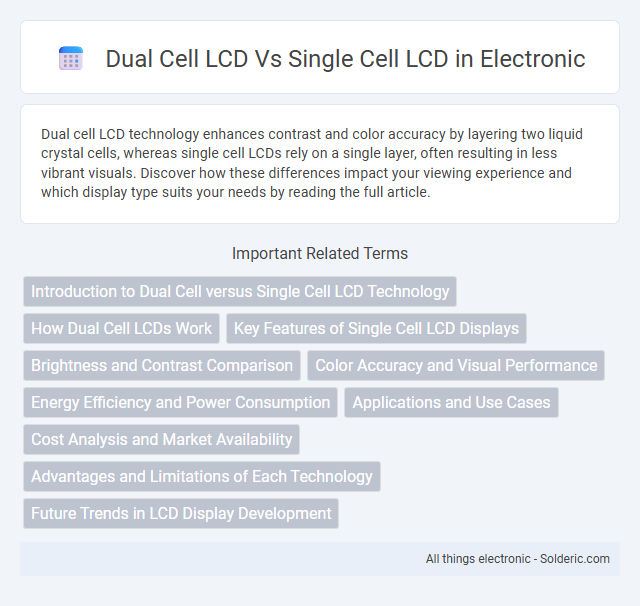Dual cell LCD technology enhances contrast and color accuracy by layering two liquid crystal cells, whereas single cell LCDs rely on a single layer, often resulting in less vibrant visuals. Discover how these differences impact your viewing experience and which display type suits your needs by reading the full article.
Comparison Table
| Feature | Dual Cell LCD | Single Cell LCD |
|---|---|---|
| Structure | Two LCD panels stacked | Single LCD panel |
| Contrast Ratio | Higher contrast, deeper blacks | Standard contrast levels |
| Viewing Angle | Improved viewing angles | Limited viewing angles |
| Response Time | Typically slower due to dual layers | Faster response time |
| Color Accuracy | Enhanced color performance | Standard color accuracy |
| Power Consumption | Higher power consumption | Lower power consumption |
| Cost | More expensive | More affordable |
| Applications | High-end monitors, professional displays | Standard consumer displays |
Introduction to Dual Cell versus Single Cell LCD Technology
Dual Cell LCD technology uses two liquid crystal layers to enhance contrast and improve black levels compared to Single Cell LCDs, which rely on a single layer. This advanced configuration allows Dual Cell displays to achieve better image depth and color accuracy, making them ideal for high-end TVs and professional monitors. Your viewing experience benefits from sharper visuals and reduced light leakage, especially in dark scenes.
How Dual Cell LCDs Work
Dual Cell LCDs operate by layering two liquid crystal panels to enhance image quality, contrast ratios, and black levels compared to Single Cell LCDs. The primary panel handles color reproduction and image generation, while the secondary panel functions as a dynamic light modulator, effectively increasing the display's local dimming capabilities. This dual-layer approach allows Dual Cell LCDs to achieve deeper blacks and higher contrast without the blooming effects typical of traditional Single Cell LCDs.
Key Features of Single Cell LCD Displays
Single cell LCD displays feature a single liquid crystal layer between two glass substrates, offering simplicity and lower production costs compared to dual cell LCDs. These displays provide clear image quality with adequate brightness and contrast, suitable for standard applications where advanced color accuracy and wider viewing angles are not critical. The design allows for faster response times and reduced power consumption, making single cell LCDs ideal for everyday consumer electronics and basic display needs.
Brightness and Contrast Comparison
Dual cell LCD technology offers significantly higher brightness levels compared to single cell LCDs by utilizing two liquid crystal layers that enhance light transmission and reduce light loss. The increased contrast ratio in dual cell LCDs results from improved light control, allowing deeper blacks and more vibrant colors, which single cell LCDs struggle to achieve due to light leakage. This technology is especially advantageous in HDR displays, delivering superior visual performance in bright ambient conditions.
Color Accuracy and Visual Performance
Dual cell LCDs enhance color accuracy by incorporating two liquid crystal layers, which improve light modulation and deeper contrast ratios compared to single cell LCDs. This results in richer, more vibrant colors and better visual performance, especially in high dynamic range (HDR) content. Your viewing experience benefits from reduced color bleeding and sharper image quality, making dual cell technology superior for professional and entertainment displays.
Energy Efficiency and Power Consumption
Dual cell LCD technology significantly improves energy efficiency by incorporating two liquid crystal layers that enhance light modulation, reducing the need for strong backlighting compared to single cell LCDs. Single cell LCDs rely heavily on constant backlight intensity to achieve desired brightness, leading to higher power consumption. The dual cell design allows for dynamic light control, lowering overall power usage and extending battery life in portable devices.
Applications and Use Cases
Dual cell LCD technology enhances display brightness and contrast, making it ideal for outdoor applications such as automotive dashboards, digital signage, and wearable devices where visibility in direct sunlight is critical. Single cell LCDs are commonly used in smartphones, tablets, and laptops where lower power consumption and thinner design are prioritized over extreme brightness. The choice between dual and single cell LCDs depends on specific use cases, balancing display clarity, power efficiency, and environmental lighting conditions.
Cost Analysis and Market Availability
Dual cell LCDs typically incur higher manufacturing costs due to their layered structure, which enhances display quality but requires more complex assembly processes. Single cell LCDs are more cost-effective and widely available in the market, making them the preferred choice for budget-sensitive applications. You can expect dual cell LCDs to be found primarily in niche markets prioritizing superior color accuracy and contrast, while single cell LCDs dominate mainstream consumer electronics.
Advantages and Limitations of Each Technology
Dual cell LCD technology offers superior contrast ratios and deeper black levels by stacking two LCD panels, which enhances image quality significantly compared to single cell LCDs. Single cell LCDs benefit from lower power consumption and reduced manufacturing costs, making them more affordable and efficient for everyday use. Your choice depends on whether you prioritize image clarity and contrast or energy efficiency and budget.
Future Trends in LCD Display Development
Dual cell LCD technology offers enhanced contrast ratios and deeper blacks compared to single cell LCDs, making it a promising direction for future display innovations. Research is focused on integrating dual cell structures with advanced backlighting and quantum dot enhancements to improve color accuracy and energy efficiency. As consumer demand shifts towards high dynamic range (HDR) and lower power consumption, dual cell LCDs are expected to gain traction in premium monitors and TVs.
Dual cell LCD vs Single cell LCD Infographic

 solderic.com
solderic.com